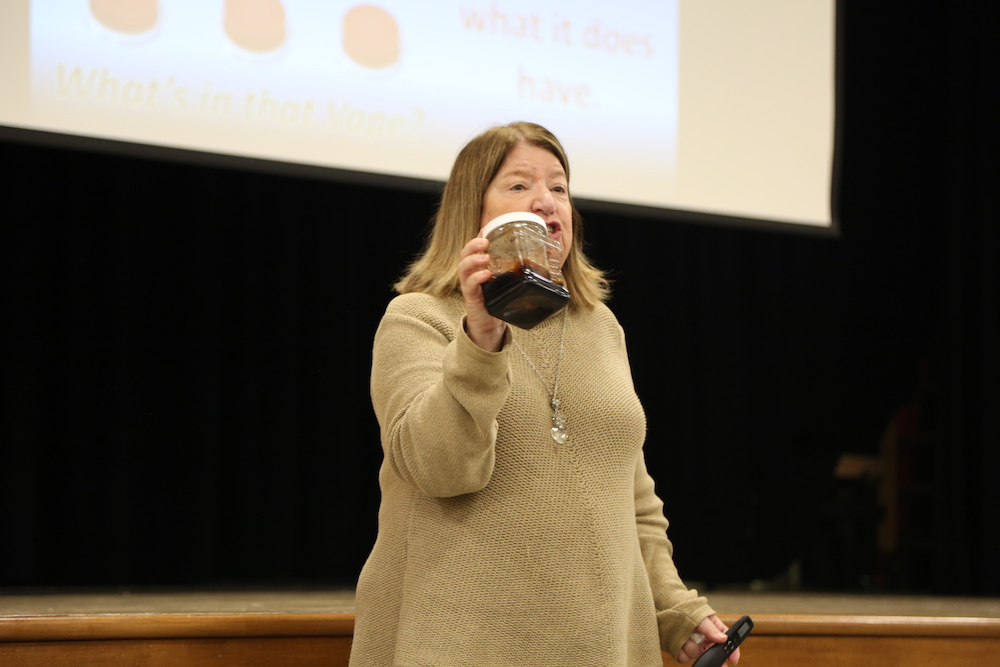Workshop focuses on dangers of e-cigarette use among students

Roughly 40 percent of Riverhead Middle School students believe vaping is not harmful to their health, according to data collected last year by the Riverhead Youth Coalition, a group of students in grades seven through 12 whose goal is to prevent drug and alcohol abuse among youth.
Every two years, Riverhead Community Awareness Program survey students in grades six, eight, 10 and 12 on drugs, alcohol and risky behaviors. Vaping among eighth grade students during the past 30 days (a sign of regular use) doubled between 2016 and 2018, from roughly 10 percent to 22 percent, according to the survey. That represents over a 100 percent increase.
Bonnie Anderson, senior health educator in the Suffolk County Department of Health, and Lindsay Lindenbaum, a health teacher at Riverhead Middle School, outlined some of the results of those surveys and led a discussion on the harmful effects of electronic cigarettes Monday at the middle school, where parents and community members were invited to discuss the popular form of vaping among teenagers.
E-cigarette devices heat a liquid into an aerosol that users inhale, according to the U.S. Surgeon General. The liquid usually contains addictive nicotine, flavoring and other additives.
An informal survey conducted by Ms. Lindenbaum revealed 44 percent of 273 eighth-grade students in the district admitted to trying a vape product and 10 percent of students currently vape.
“That’s way too high, especially for middle school students,” she said. “Lack of governmental regulation, availability, false advertising and the belief that e-cigarettes are not harmful or addictive have lured teens to this new, cool product.” While the Food and Drug Administration placed regulations on e-cigarettes in 2018, Ms. Anderson said, vape “juice” and liquid is often mislabeled, leading teens to believe the products aren’t as harmful as they really are.
Most vape liquid, which is inserted onto a heated coil, is geared toward kids, Ms. Anderson said.
“I don’t know of a 50-year-old man who’s going to vape Pokémon juice,” she said.
For example, the most popular smoking device, Juul — a vaporizer that uses pods — is advertised as having less nicotine in one pod than a pack of cigarettes, she said. But each Juul pod contains 59 mg of nicotine, while a pack of cigarettes typically has 20 mg of nicotine. Other e-cigarettes average 18-36 mg, she said.
“They don’t even know what they’re vaping. They really have no clue,” she said.
Kelly Miloski, community prevention specialist with Riverhead CAP, talked about prevention services CAP offers specific to vaping and encouraged parents to get more involved with the coalition. She noted how three out of four eighth graders felt they could talk to their parents if they had a problem and three out of four reported that their parents had discussed the dangers of drugs and alcohol within the past year, according to the 2018 survey.
Youth members from the Riverhead Youth Coalition said during a presentation that they suggested parents contact the Riverhead Town Board about limiting the number of vape shops in town and the advertising on the windows of shops already in place.
Felicia Scocozza, executive director of Riverhead CAP, also suggested parents contact their legislators (Bridget Fleming or Al Krupski) to support a bill the County Legislature is considering to ban flavored e-juice. The bill is currently tabled.
Members of the Riverhead Youth Coalition will be meeting with the legislators to give their input on the issue, Ms. Scocozza said.
The use of e-cigarettes has grown in the past few years, especially among teens, officials say.
In January, County Executive Steve Bellone started a vaping prevention program called Vape Out for schools throughout Suffolk County.
Peer-to-peer counseling, parent education forums and e-cigarette education are all part of the program, which has been implemented in schools in North Babylon, Hampton Bays, Port Jefferson and Bayport-Blue Point.
Ms. Lindenbaum said the solution starts with parents educating their children on the harmful effects of vaping.
“Teen vaping is quickly becoming an epidemic,” she said. “True prevention starts at home.”
Corrections: A percent increase describing the number of middle school students who believe vaping is not harmful was inaccurate. There was no comparable data point from 2016 which to compare. Also, Riverhead CAP performs the youth survey every two years, not with the Riverhead Youth Coalition. Also, comments attributed to Kelly Miloski should have been attributed to Felicia Scocozza.
Photo caption: While e-cigarettes don’t have tar that’s present in regular cigarettes, Suffolk County Department of Health senior health educator Bonnie Anderson said they do contain plenty of other harmful chemicals. (Kate Nalepinski photo)









